Gupta D. (Ed.). Diffusion Processes in Advanced Technological Materials
Подождите немного. Документ загружается.

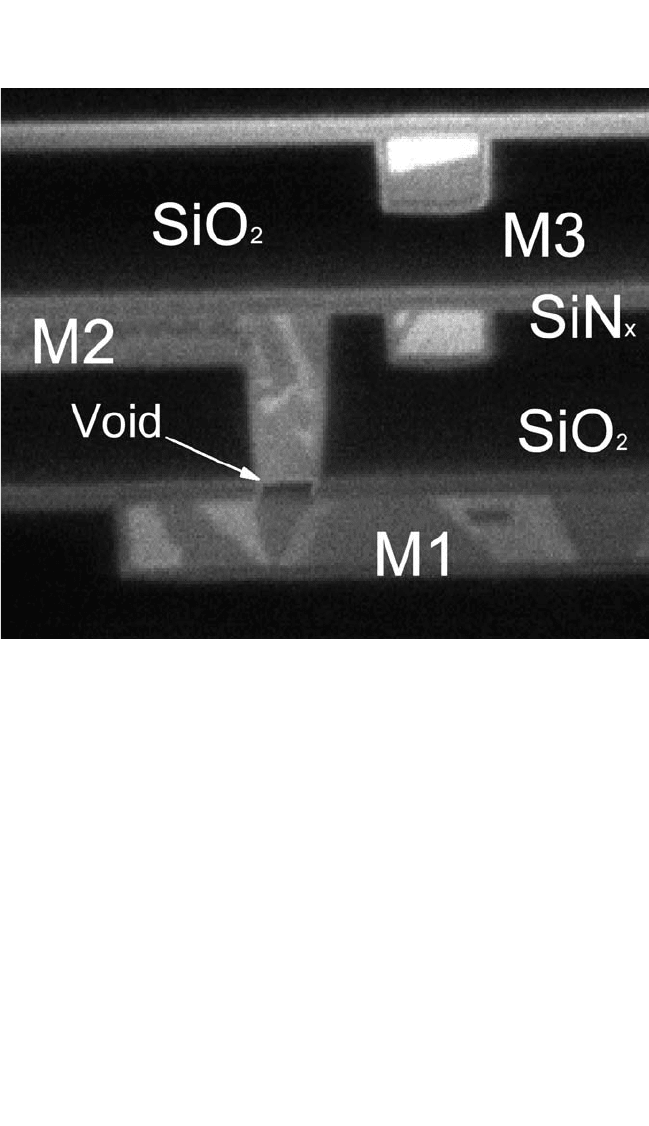
lifetime for both cases should be within an order of magnitude. Therefore,
lifetimes of around 180 to 340 hours were observed in the late-failure
group with the 30-nm-thick liner and the first-failure group with the 3-nm-
thick liner, respectively.
The Cu interconnections discussed above were embedded in SiO
2
with near-vertical vias and thin liners on via side walls. When a void
grew in the via bottom during electromigration testing, the thin liner at
the via/line interface could not withstand the high current and caused a
large resistance increase or line open. We will next discuss the case of
Cu interconnects embedded in high-thermal-expansion-coefficient
SiLK dielectric with shallow sloped via and thick liner structures. Cu
interconnects in SiLK should generate higher tensile stresses in the Cu
line/via region than in CuSiO
2
structures. This could result in a less
favorable site for vacancy flow to the via bottom, which would then
reduce the fraction of the first mode failure population (see Sec. 9.11.2).
452 DIFFUSION PROCESSES IN ADVANCED TECHNOLOGICAL MATERIALS
Figure 9.31 FIB image of a sample with a 30-nm-thick liner at the bottom of V1
showing an interface void.
Chapter-09 11/29/04 6:50 PM Page 452

ELECTROMIGRATION IN CU THIN FILMS, HUETAL. 453
In addition, a thick liner could provide a path for stable current pas-
sage where a marked sharply resistance increase would not occur when
a void grew across the via or line. For a lifetime, for example, at
∆RR
o
20% with a typical Cu line length of 400 mm, the test lines
with via bottom voids would have sufficient time for the void to grow
into a line/via void location. We expect that interconnects with a stable
liner would have reduced the distribution in the first-failure lifetime
group and resulted in a single log-normal lifetime distribution.
9.9 Current Density Dependence
Figure 9.32 shows a plot of mean lifetime t as a function of
current density for 0.28-mm-wide single-damascene Cu lines on W
[Fig. 9.3(b)] at 370°C. In this structure, the cathode end of the line is
connected to a completely blocking boundary; the void growth rate is
therefore equal to electromigration drift velocity. Following Eq. (7), the
Cu lifetime is t ∆L
cr
v
d
ort t
o
j
1
. However, the equation of life-
time to current density is usually expressed by t t
o
j
m
, where t
o
is a
constant. The value of m will be determined by the experimental data.
The values of m in Fig. 9.31 from the data of 0.28-mm-wide-line
CuSiO
2
structures were found to be 1.1 ± 0.2 for j 25 mAmm
2
and
1.8 for j from 25 to 140 mAmm
2
. The value of m 1 is consistent with
the growth of a void in the pure metal as predicted by Eq. (7), while the
value of m 1.8 is believed to be dependent on the power used, the crit-
ical void size, the liner thickness and resistivity, the contact resistance,
the surrounding material, and the ambient, which strongly reflects a
local joule-heating effect from the liner, as discussed in Sec. 9.6. When
extrapolating to the actual use condition from accelerated testing, this
nonlinear dependence must be considered, especially in the case where
accelerated test current density is above the 25-mAmm
2
level for the
0.28-mm-wide lines and the use current density is lower. For fat wires,
1-mm-wide and 1-mm-thick Cu damascene lines in polyimide dielectric,
the value of m 2.2 was observed,
[119]
which deviates greatly from 1.
This is probably due to the poor thermal conductivity of polyimide and
the high power used in the fat lines, which then reflects a large joule-
heating effect.
The relationship between lifetime and current density was further
explored by the measurements of the void growth rate as a function of cur-
rent density in a Blech-type drift velocity test structure. This type of test
structure closely resembles a two-level test line connected to W vias,
completely blocking boundaries. When a void grows at the cathode end of
the line in this interconnect structure, the liner under the void would be the
Chapter-09 11/29/04 6:50 PM Page 453

only connection between the Wvia and the remaining Cu line. Joule heat-
ing is generated from conduction through the thin liner, which then causes
increased drift velocity, especially in a higher current density case.
However, in the Blech-type test structure of Fig. 9.3(a), the underlayer is
rather thick compared to the liner in the interconnect structure, and the
joule-heating effect is minimized. Therefore, the void growth rate in the
Blech-type test structure would be a good test sample in which to exam-
ine the electromigration void growth rate theory. The typical resistance
changes, ∆R, corresponding to void growth as a function of time for
Ta/Cu/Ta line segments on W are plotted in Fig. 9.33. The linear behavior
of these lines indicates that the resistance change rate (corresponding to
drift velocity) of Cu is independent of time. The line intercept is a time
close to zero, which suggests little incubation time in pure Cu lines. The
resistance change rate related to drift velocity as a function of current den-
sity is plotted in Fig. 9.34. The current density exponent measured from
the resistance change rate or drift velocity can be directly applied to
454 DIFFUSION PROCESSES IN ADVANCED TECHNOLOGICAL MATERIALS
Figure 9.32 Plot of log mean lifetime (t) as a function of log(j) for 0.28-mm-
wide lines.
Chapter-09 11/29/04 6:50 PM Page 454

ELECTROMIGRATION IN CU THIN FILMS, HUETAL. 455
failure lifetime as t t
o
j
m
proportion to (∆R∆t)
m
due to the constant
electromigration drift velocity in the pure metallic films. The value of the
measured exponent, m, of the current density for pure Cu was found to be
1.1 ± 0.2, which is in good agreement with the theoretically predicted
value of 1 in a pure metal, as given in Eq. (1).Although m 3.6 has been
reported in the literature from a single-stripe test structure (with pads as
reservoirs),
[88]
it was obtained on a different test structure than that
described here.
Figure 9.33 Line resistance change vs. electromigration test time.
Chapter-09 11/29/04 6:50 PM Page 455
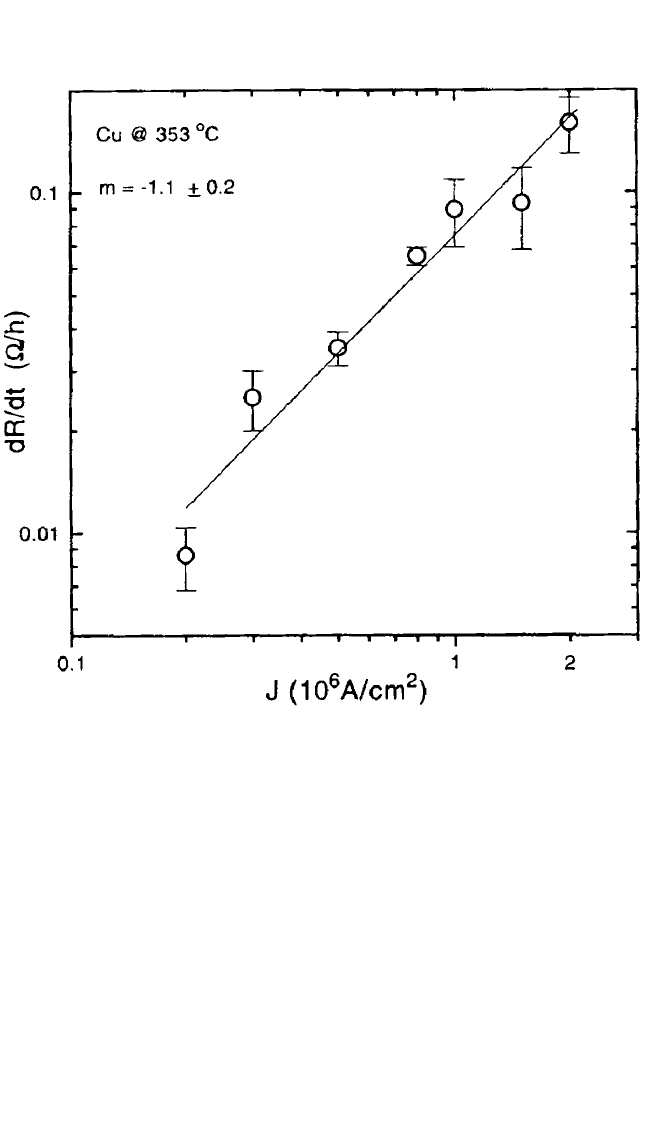
For the dual-damascene line on W, the lifetime distribution is a mul-
tiple failure distribution function, and a large number of samples is
required to obtain reasonably accurate data. Abimodal distribution func-
tion, Eq. (16), is used for fitting the cumulative failure probability. The
sample temperature was set at 296°C in this case. The variation of life-
time distributions for the samples taken from the same wafer is small.
However, the median lifetimes from one wafer to another wafer can vary
by a factor of 2, which is influenced by a slight variation in the wafer fab-
rication processing, such as linewidth and thickness, line/via overlap
area, cleaning steps, or Cu/SiN
x
interface property. Figure 9.35 shows
cumulative lifetime distributions obtained from three wafers. The data
shift among wafers is shown. Seven wafers were used to obtain the rela-
tionship between lifetime and current density. To overcome the statistical
456 DIFFUSION PROCESSES IN ADVANCED TECHNOLOGICAL MATERIALS
Figure 9.34 Plot of resistance change rate (drift velocity) as a function of current
density j for pure Cu.
Chapter-09 11/29/04 6:50 PM Page 456
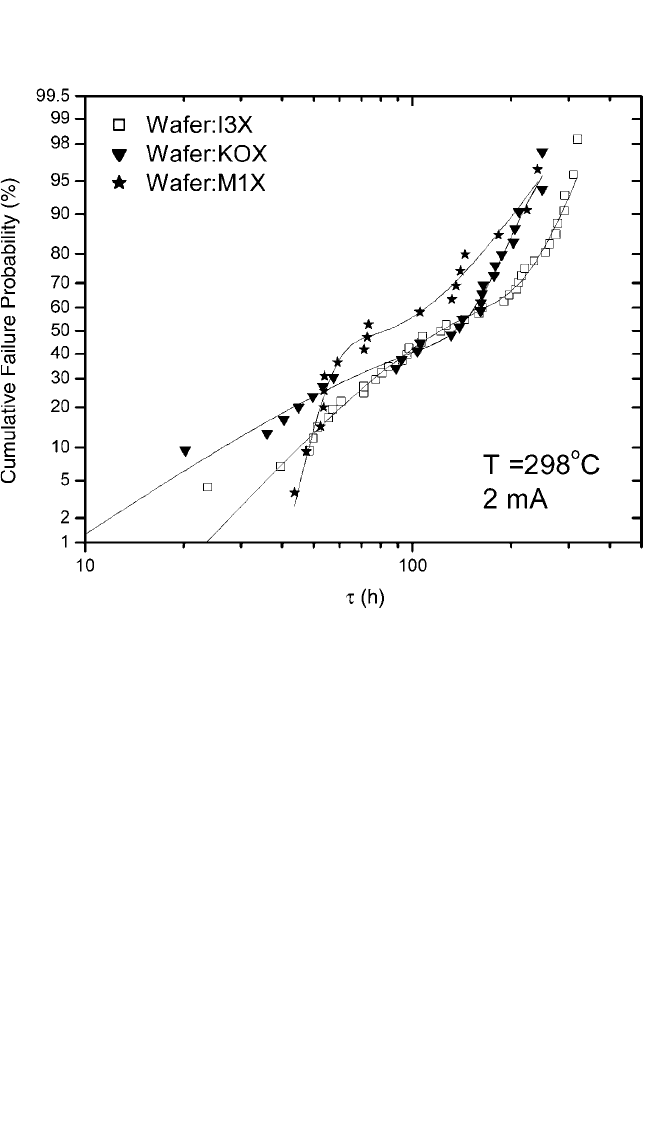
ELECTROMIGRATION IN CU THIN FILMS, HUETAL. 457
error from the wafer variation, the lifetime of every wafer was measured
at a current of 2 mA (30 mAmm
2
). The scaling factors between the
wafers were obtained by normalizing the median lifetimes at 30 mAmm
2
to a chosen wafer. Then the median lifetimes from the other current den-
sities were normalized according to these scaling factors. Figure 9.36
shows the median lifetime of t
1
and t
2
as a function of current. The aver-
age sample temperature increase from the Joule heating at the beginning
of the current stress test was estimated from the test line resistance as a
function of current and temperature. The relationship between R and T
within the 25 to 350°C temperature range was found to be linear, with a
temperature coefficient of resistance (a) measurement of 0.0032Ω°C.
Using test line resistance as a function of current and the value of a, the
average sample temperature increase due to joule heating was found to
be less than 3°C when 7 mA was applied. No attempt at sample temper-
ature correction from joule heating was made, although the temperature
Figure 9.35 Cumulative percentage failure vs. t on a log-normal scale from three
different wafers. The curves are the least-squares fits of the data to the bimodal
function.
Chapter-09 11/29/04 6:50 PM Page 457
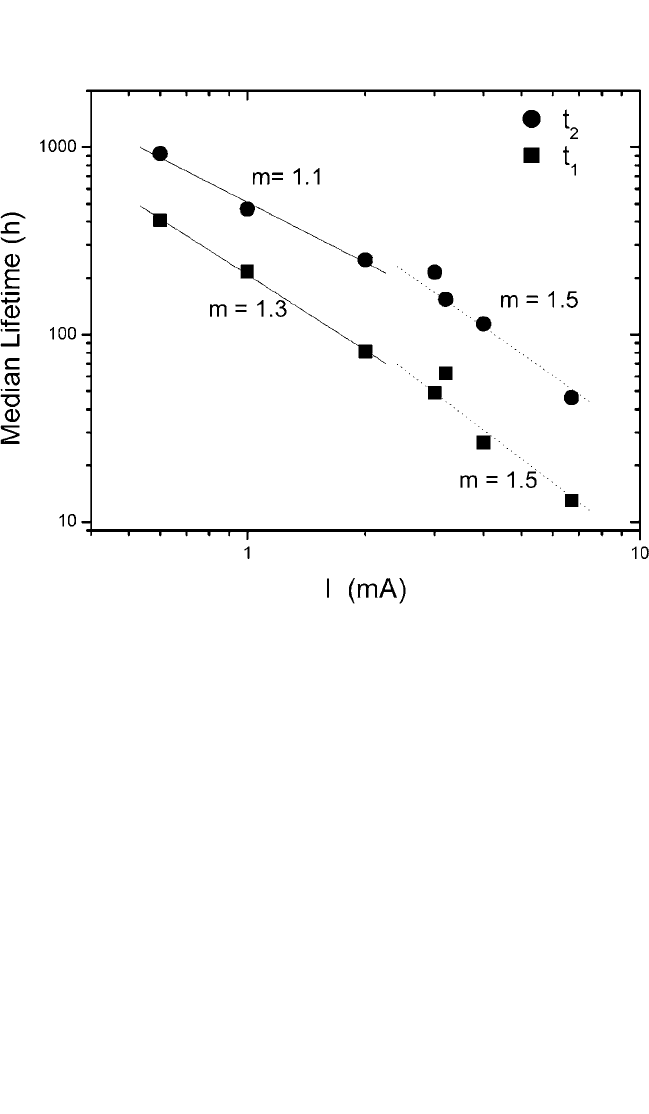
rise at the Wvia bottom contact area could be higher. Values for the cur-
rent density exponent for a current density 30 mAmm
2
was found to
be m 1.3 for t
1
and 1.1 for t
2
, which reflected the possible contribution
of joule heating to the contact resistance at the W/TaN/Ta/Cu via bottom
interface.
9.10 Lifetime vs. Linewidth
In the Cu interconnection structure of Fig. 9.3(b), a W stud is con-
nected to a Cu damascene line that has the top surface covered by sili-
con nitride and the bottom and sides covered with a TaNTa liner. If it
is assumed that diffusion at the top Cu/silicon nitride interface domi-
nates in Cu, the electromigration flux is constrained to the top interface
in an area of d
s
w, where d
s
is the effective thickness of the interface
region and w is the linewidth. Then the relative amount of flux, at constant
458 DIFFUSION PROCESSES IN ADVANCED TECHNOLOGICAL MATERIALS
Figure 9.36 Plots of median lifetimes vs. log (current). The solid and dotted lines
are the least-squares fits of the data below and above 2.5 mA, respectively.
Chapter-09 11/29/04 6:50 PM Page 458

ELECTROMIGRATION IN CU THIN FILMS, HUETAL. 459
line current density, j, flowing through the interface region is propor-
tional to the interface area/line area ratio, d
s
w(wh) or d
s
h, where h is
the line thickness. The lifetime, t, obtained from Eqs. (1) and (8) can be
written as follows:
t ∆L
cr
h kT(d
s
D
s
Z
*
s
erj), (18)
where ∆L
cr
is the critical void length and D
s
is the Cu/SiN
x
interface
diffusivity. To verify Eq. (18), chips with 0.69-, 0.26-, and 0.24-mm-
wide M2 lines were tested using a Fig. 9.3(d) test structure. The elec-
trons flowed from V2 to M2, and the thickness of the via bottom liner
was 10 nm. After testing, the samples were examined by FIB or SEM
on cross sections prepared by FIB. The FIB or SEM images revealed
that the typical degradation mode of void formation was at the cathode
end of the M2 under the bottom of the V2 liner. The void growth was
due to Cu drift away from the M2V2 interface. The observation sug-
gested that the 10-nm-thick diffusion barrier liner at the V2M2 inter-
face was thick enough to block the Cu migration from M3 to V2 to M2
when the M3 current density was only j 1 mAmm
2
. The typical
value of s in the log-normal failure distribution was about 0.4. The var-
ious void locations and shapes near the cathode end of the M2 lines
were found to be the main reason for the spread of lifetime in the life-
time distribution. In general, if a void only grew from the top surface
of the M2 (grain thinning
[86, 103]
) under the V2 and caused the Cu to dis-
connect between Cu M2 and V2, a rapid line resistance change and a
short electromigration lifetime would result, as seen in Fig. 9.37(a).
However, if a void grew by edge displacement (vertical voiding) to
deplete all the M2 Cu under V2 [see Fig. 9.37(b) and 9.27(a)], or the
grain surface thinned at a distance away from the V2 liner, a long
lifetime could be obtained. A vertical void can be created when Cu
migrates along the top surface of the Cu line and is then fed by Cu
atoms from the bottom of the Cu line. Alarge volume of mass in a ver-
tical void has to be removed before a marked line resistance change can
take place. Similar behavior has been reported for electromigration in
Al interconnections.
[120]
Figure 9.38 shows the median lifetime, t
50
, as a function of linewidth
at constant thickness at sample temperatures of 244 and 309°C. The life-
times are nearly independent or increase slightly as linewidth decreases,
which is contradictory to the Cu/liner interface diffusion model. The
model predicts that the lifetime would drop by a factor of 1.9 in tests
where linewidth is changed from 0.69 to 0.24 mm [see Eq. (5)]. The data
shown in Fig. 9.38 are mostly consistent with the proposed model that Cu
Chapter-09 11/29/04 6:50 PM Page 459
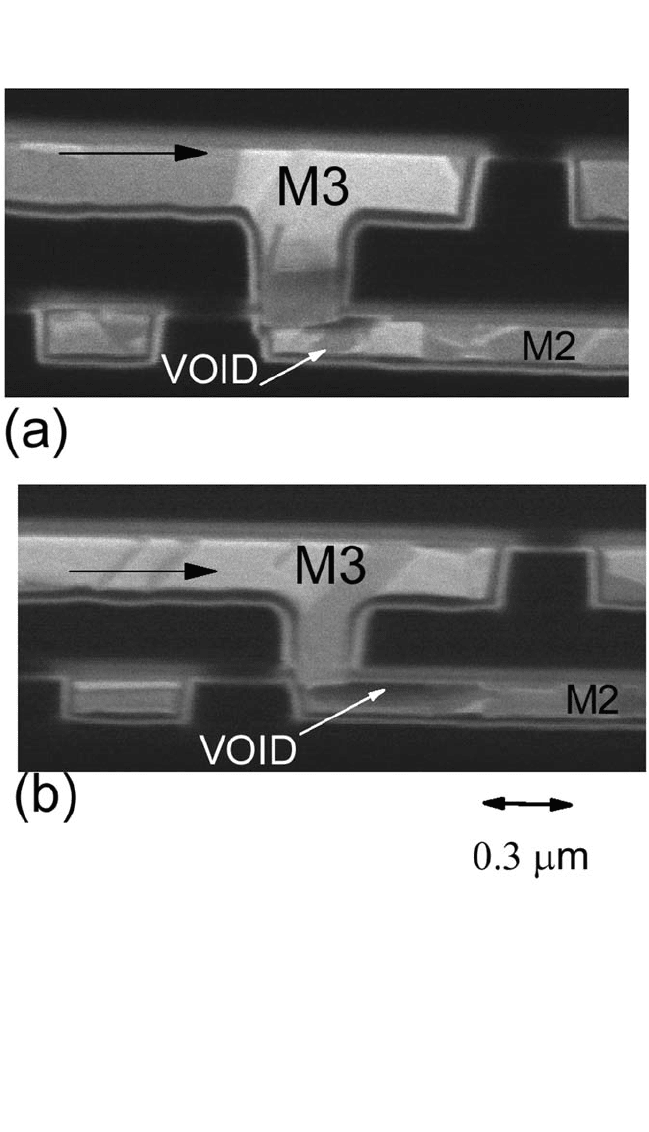
atoms migrate along the top CuSiN
x
interface and the lifetime is pro-
portional to thickness only as in Eq. (5). According to Eq. (18), the
electromigration Cu lifetime in a bamboo-like grain structure line is
proportional to the Cu migration rate, the (metal line thickness)
1
depend-
ence, and the via/line overlap section that defines the critical ∆L
cr
. All val-
ues for the 0.24- to 0.69-mm-wide lines were tested in this study. A slight
460 DIFFUSION PROCESSES IN ADVANCED TECHNOLOGICAL MATERIALS
Figure 9.37 FIB images of electromigration damage samples tested for (a) 18 hours
and (b) 42 hours.
Chapter-09 11/29/04 6:50 PM Page 460
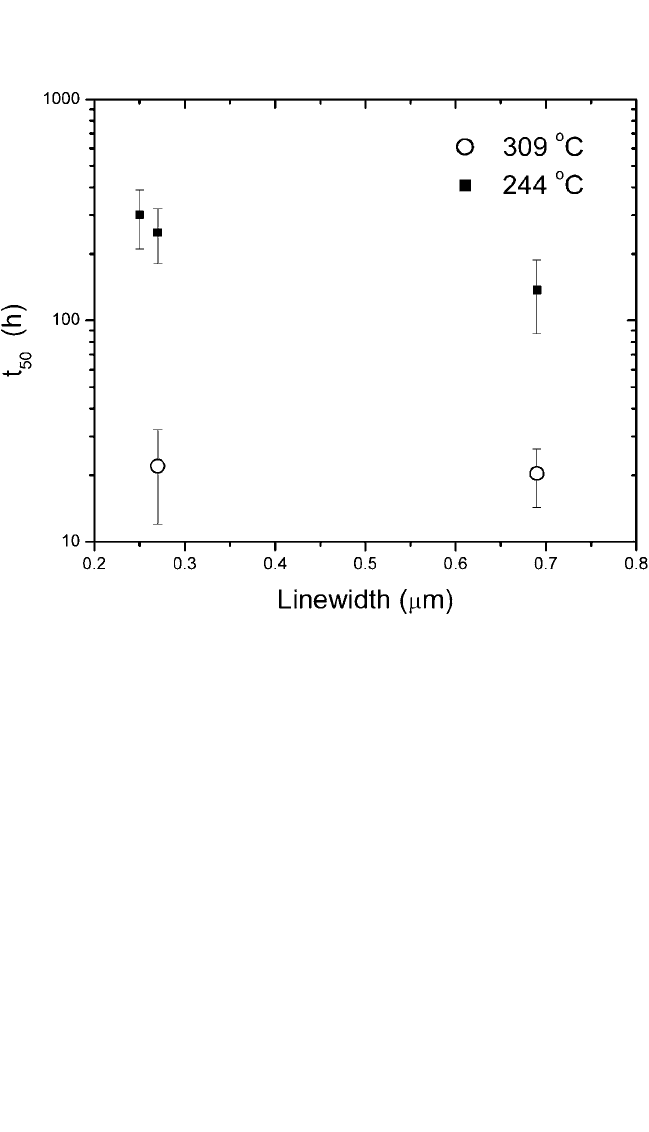
ELECTROMIGRATION IN CU THIN FILMS, HUETAL. 461
improvement in lifetime for narrow lines is partially due to the possibility
of an additional fast path from grain boundary diffusion in wide lines and
partially due to the small V2 via diameter of 0.3 mm on the wide 0.69-mm-
wide M2.
9.11 Lifetime Scaling Rule
9.11.1 Single-Damascene Line
In Cu damascene structures, the top surface is covered by silicon
nitride, and the bottom and sides are covered with a Ta-based liner.
Diffusion at the top Cu/silicon nitride interface dominates in Cu for
bamboo microstructure lines. The lifetime, t, from Eq. (18) can then be
simplified to:
t C ∆L
cr
hD
s
, (19)
Figure 9.38 Mean lifetime vs. metal linewidth. The electron flow was from V2 to
M2 using a Fig. 9.3(c) test structure.
Chapter-09 11/29/04 6:50 PM Page 461
